Opera Hispanica at Consulate Argentina
Story and photos by Keith Widyolar
March 7, 2013
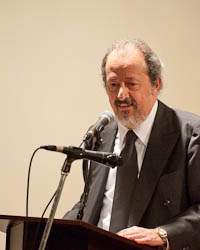
Jose Luis Perez Gabilonda
The Opera Hispanica Festival opened last night at the Consulate of Argentina with a performance hosted by the Consul General of Argentina in New York, Jose Luiz Perez Gabilonda. There were several diplomats in the audience including Juan Ramon Martinez Salazar and Iñigo Ramirez de Haro from the Consulate of Spain, and Maria Elena Cabezut from the Consulate of Mexico.
It was an evening of compositions primarily by Astor Piazzolla. Astor spent his teen years here in New York. It was here that Piazzolla absorbed classical influences from his Russian piano teacher and the jazz which became tango jazz in his hands. It is worth noting that Piazzolla’s music was not accepted at first in Argentina. People said, it was not tango. Today Piazzolla’s tango jazz has become the standard tango form and is loved universally. Opera Hispanica stretches the tango even further by taking Piazzolla’s music to the opera.
Yves Dharamraj (cello) and Sami Merdinian (violin) opened with a performance of Astor Piazzolla’s “Oblivion.” Whenever I hear “Oblivion” I am not sure whether I am dying or being born. It always takes me back to a palace on the banks of the Bosphorus in Istanbul where musicians who would become my good friends there and in Paris played it at a tango festival.
Transported by the music, I made the fateful decision in that moment to embrace my tango journey which led through New York to Buenos Aires, Paris, Istanbul, and Amsterdam before releasing me into the waiting arms of New York’s Latin Culture. Such is the power of the tango whose honest embrace can transcend the individual, complete the couple, and connect all with the universal spirit.
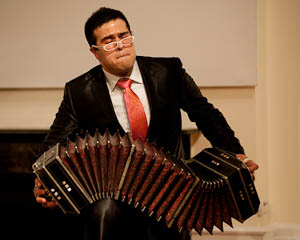
Juan Pablo Jofre
The rising star bandoneon player, Juan Pablo Jofre, continued with his own composition “Tango Movements.” The piece was inspired by his decision during the 2001 financial crisis in Argentina to become a bandoneon player and his mother’s upset at her son’s choice. You could hear clearly the tension of the crisis, his thoughtful decision and his mother’s upset, stronger at first becoming more calm with the passage of time.
Juan Pablo is tremendously talented. His composition is less familiar than Piazzolla, but equally absorbing. They don’t make bandoneons anymore, but apparently they still make great bandoneon players.
What is the connection between Argentina and Opera? When you think Opera, you probably first think Italian. Well, the Argentines are descended mostly from Italians who immigrated to Argentina at the same time as the great Italian migration to New York. So in the same way that the Italians naturally love tango, the Argentines naturally love opera. It is in their blood.
The evening continued with the first vocals sung by Argentine baritone Gustavo Feulien. He sang a set of songs from the famous collaboration of two Argentine creative giants, writer Jorge Luis Borges and composer Astor Piazzolla.
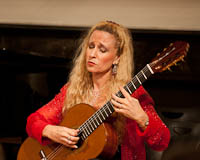
Tali Roth
It was strange at first to hear the tango expressed as opera. I couldn’t help but wonder if the opera singer was the original model for the Tango singer. I got so excited in this thought that I forgot to take his photo.
Classical guitarist Tali Roth played parts of “Milonga del Angel” and “Adios Nonino,” the famous piece that Piazzolla wrote on the passing of his grandfather. Roth put tremendous nostalgia in those strings because after all, the classic tango form first established by Carlos Gardel is all about quenching the pain of love lost.

Isabel Leonard
Isabel Leonard (mezzo-soprano) of the Metropolitan Opera sang “Cinco Canciones Negro,” a piece authored by the great Spanish composer Xavier Montsalvatge. Being about Cuba, it was inspired by the last cherished piece of the Spanish empire, the loss of which ironically marked the beginning of the American empire.
Music Director Jorge Parodi introduced the piece by explaining that at first Ms. Leonard wasn’t sure she would have time to perform in the festival, so he played his Argentinean card and reached out to her Argentine mother. In the end, Ms. Leonard was delighted to perform.
It is a pleasure to experience opera up close. The sensations are very different from watching opera on a big stage. Leonard sang with such grace and poise that you couldn’t help but wonder how one person just standing at a piano could express so many different emotions. Look for Ms. Leonard at Carnegie Hall April 9th.
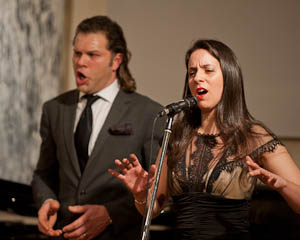
Marcelo Guzzo and Malena Dayen
The delightful evening closed with an operatic version of Piazzolla’s “Maria de Buenos Aires.” “Yo soy Maria, de Buenos Aires…” Who is she really? Angel or devil? Since my encounter with oblivion that day in Istanbul, I am sure that I have met both Marias. Certainly I have seen them both in the mirror.
One of the surprises of the evening was the breadth of styles and the unique calibre of the performances. I thought this was going to be a night of straight ahead opera, just like all the other operas you’ve seen. My mother was the president of the Opera Society in Orange County, California where I grew up. I’ve seen many great operas, but never much cared for them.
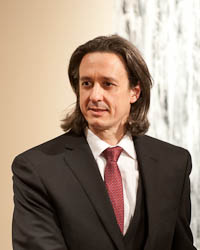
Artistic Director Jorge Parodi
The artists of Opera Hispanica approach the form in a slightly different way that is not Italian, French or German. If you love the tango, you probably haven’t heard it expressed quite like this. And if you love the opera, you probably haven’t heard it sung like this either.
Don’t miss the rest of the Opera Hispanica Festival.
Copyright © 2013 Keith Widyolar. All Rights Reserved.
~
Opera Hispanica Festival
Zarzuela: What’s in a name?
Queen Sofia Spanish Institute
Thursday March 7, 7pm
Pasiones! The Pulse of Zarzuela
Americas Society
Friday March 8, 7pm
Martina Arroyo Master Class
Manhattan School of Music
Thursday March 14, 4pm
Maria de Buenos Aires
Le Poisson Rouge
Friday March 15 and Sunday March 17, 7:30pm
